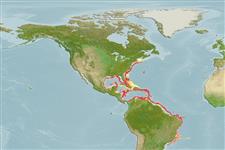Classification / Names
Nomi Comuni | Sinonimi | Catalog of Fishes(Genere, Specie) | ITIS | CoL | WoRMS | Cloffa
>
Gadiformes (Cods) >
Moridae (Morid cods)
Etymology: Laemonema: Greek, laimos = throat + Greek, nema = filament (Ref. 45335).
Eponymy: Artificial combinations of the names of both George Brown Goode (above) and Tarleton Hoffman Bean (q.v.). (See Goode and Bean, TH) (Ref. 128868), visit book page.
Environment: milieu / climate zone / depth range / distribution range
Ecologia
marino benthopelagico; distribuzione batimetrica 180 - 792 m (Ref. 31160). Subtropical; 43°N - 26°S
Western Atlantic: off Canada to off southern Brazil; including the Gulf of Mexico, off French Guiana and off Suriname.
Size / Peso / Age
Maturity: Lm ? range ? - ? cm
Max length : 27.3 cm SL maschio/sesso non determinato; (Ref. 128822); peso massimo pubblicato: 191.50 g (Ref. 128822)
Raggi dorsali molli (totale) : 66 - 73; Raggi anali molli: 65 - 71; Vertebre: 56 - 59. Height of the first dorsal fin 10.1-17.1%SL, average 13.8%SL. Interorbital narrow, 3.4-4.7%SL. Orbit diameter 6.4-8.3%SL.
Life cycle and mating behavior
Maturità | Riproduzione | Deposizione | Uova | Fecundity | Larve
Meléndez, C., R. and D.F. Markle, 1997. Phylogeny and zoogeography of Laemonema and Guttigadus (Pisces: Gadiformes: Moridae). Bull. Mar. Sci. 61(3):593-670. (Ref. 31160)
IUCN Red List Status (Ref. 130435: Version 2024-2)
Threat to humans
Harmless
Human uses
Strumenti
Special reports
Download XML
Fonti Internet
Estimates based on models
Preferred temperature (Ref.
123201): 9.3 - 18.4, mean 13.3 °C (based on 112 cells).
Phylogenetic diversity index (Ref.
82804): PD
50 = 0.5000 [Uniqueness, from 0.5 = low to 2.0 = high].
Bayesian length-weight: a=0.00479 (0.00263 - 0.00872), b=3.16 (2.99 - 3.33), in cm total length, based on LWR estimates for this species & (Sub)family-body (Ref.
93245).
Trophic level (Ref.
69278): 3.5 ±0.5 se; based on size and trophs of closest relatives
Resilienza (Ref.
120179): Medio, tempo minimo di raddoppiamento della popolazione 1.4 - 4.4 anni (Preliminary K or Fecundity.).
Fishing Vulnerability (Ref.
59153): Low vulnerability (23 of 100).
